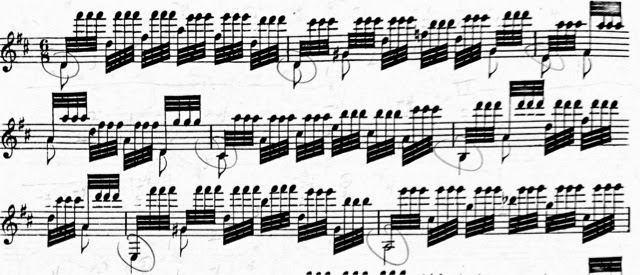TONE
One of the early realizations I had with tremolo had to do with tone. The sound we strive to perfect, that thick, warm, resonant, fat tone that so identifies a classical guitar is precisely the opposite of the desirable tone for tremolo. Using a thin, naily sound enables the listener to readily discern each and every articulation clearly in a way that a fatter tone doesn't. Think about playing in an ambient space- a room with good natural reverb- and picture those fast, fast notes, each one warm and legato, all blurring together into a mash of indiscernible harmony. If, in the very same room, you play the tremolo with a thin tone, a tone you would normally avoid in melody playing, suddenly each and every note is crystal clear, creating an effect non-guitarists regard as pure magic (and we should, too).Obviously, once your tremolo is highly controlled, you can use a warm tone as well; in fact the gradual (or sudden) change of color is one of the most delightful devices you can apply in tremolo. And yet, if you train yourself to make a thinner sound your neutral tone for this technique, you will like the results.
(A quick word about thin tone in this context: I am referring to the sound produced when you play straight-across the nail at or near the sound hole. Not the sound we commonly refer to as ponticello or metallico. Therefore, it is the sound you get when modifying the nail angle near the sound hole, not that produced near the bridge.)
LEGATO
An oft-overlooked subtlety in the performance of tremolo works is the holding-over of melody notes to create a more legato line. This is done with such minute motor-control and subtle timing that it is, in fact, difficult. But it is also fair to say that it becomes intuitive with time and, in my own experience, seldom needs special attention once the technique (and the music) is well understood.
Take, for example, this passage from the Reverie-Nocturne of Regondi.
Note the spots where I've pencilled-in little tied 32nd notes. In each of those spots, the ideal execution is to hold the previous note over the new beat for the full extra 32nd note duration, then connect the new pitch in perfect legato. Yes, the timing of this nuance is pretty tight! And yet both the sensation of doing it this way and the resultant musical effect are quite natural.
Here it is again, this time in the Gm section of Un Sueño en la Floresta, of Barrios:
Here it is again, this time in the Gm section of Un Sueño en la Floresta, of Barrios:
In this example, I've written little unfinished ties on each note that needs to be held over. Practice rendering the device with absolute precision and perfect legato in each instance. Some will seem a bit easier than others, but all are possible once the sense of the timing is understood by both hands. The legato which emerges as a result is sublime.
You will likely find that, once you've heard these passages and others like them played TRULY legato, in this fashion, you will wince when you hear them again, in the conventional and rather choppy interpretation that is more common. Tremolo with true legato is tremolo on a higher level.
COMPLEX BASS LINES
The last thing I'd like to address in the performance of tremolo is the inherent complexity of most bass lines.
We see this in Barrios all the time, but it is evident in nearly all tremolo works and so needs a bit of special attention. When I say "complex" I'm referring to bass lines which are in fact more than one part. Typically, a tremolo accompaniment will have a two-part bass, comprised of the actual bass plus filler notes, fleshing out the harmony and serving as rhythmical place-holders for the tremolo texture. Sometimes, the accompaniment is actually a three-part texture. In each of these cases, it is important to play the part with sensitivity to the roles the various notes play.
Revisiting the opening of the Reverie-Nocturne, note the encircled bass notes. I would call these notes the bass line. All the other notes played by the thumb are essentially undifferentiated harmonic filler. This is so because the notes progress in a straight up-and-down arpeggio, simply outlining the chords:
In order to play this many parts at the same time convincingly, it is critical to understand what notes are most important, and what notes are mere filler. I like the effect of a strong bass, a very quiet "viola," and rather soft second violin and a quite strong melody, or first violin. This, of course, is "balance," the subject of several other posts on this blog. But somehow, doing it clearly and well while maintaining a consistent tremolo is challenging in a new way, and bears special attention. The most common effect I hear is that, if done "well," all the bass notes are soft but equal and the tremolo is loud. (More commonly, the bass notes are loud and the tremolo is inaudible, but this problem was addressed in my post Tremolo I). But a more musical reading of the texture would offer a more nuanced treatment of the various parts implied in the writing.
What we find in the course of the pieces, though, it that the textures change. When the player responds to these changes by playing the material with appropriate (evolving) balance, then the musical "truth" starts to really emerge. Take the tremolo opening of Un Sueño en la Floresta:
Here is another four-voice texture, with the static filler part now taken by the "second violin" and the internal moving part taken by the "viola." A bit of magic happens, though, in the fourth bar, when the two inner parts merge and present a gorgeous counter-melody while the tremolo remains still, listening. It is correct to "bring out" this counter melody, allowing it to shine, as long as, in the next measure, the original balance resumes.
Understanding how many voices are present at any one time, which ones are most prominent and which ones merely filler, and practicing for clarity of these shifting textures leads to more mature readings.
To summarize, The various challenges presented the player working on a tremolo piece are as follows:
1) Master basic bass-soft and tremolo-loud balance control
2) Learn to individually emphasize each finger for greater internal control
3) Work on gradually speeding up and slowing down your tremolo, for use in rubato phrasing
4) Consider the tone you use in playing tremolo, perhaps favoring a brighter sound than usual as neutral
5) Work on "true legato," connecting the tremolo notes over each new bass note
6) Evaluate the actual content of the accompaniment part and balance it accordingly.
There you go, no problem!! Have fun, and remember, everything you practice for the improvement of your tremolo applies DIRECTLY to other right-hand activities, so is a great investment. And never forget that non-guitarists find tremolo pieces especially appealing (and impressive) so the payoff for this work tends to be disproportionately high.





